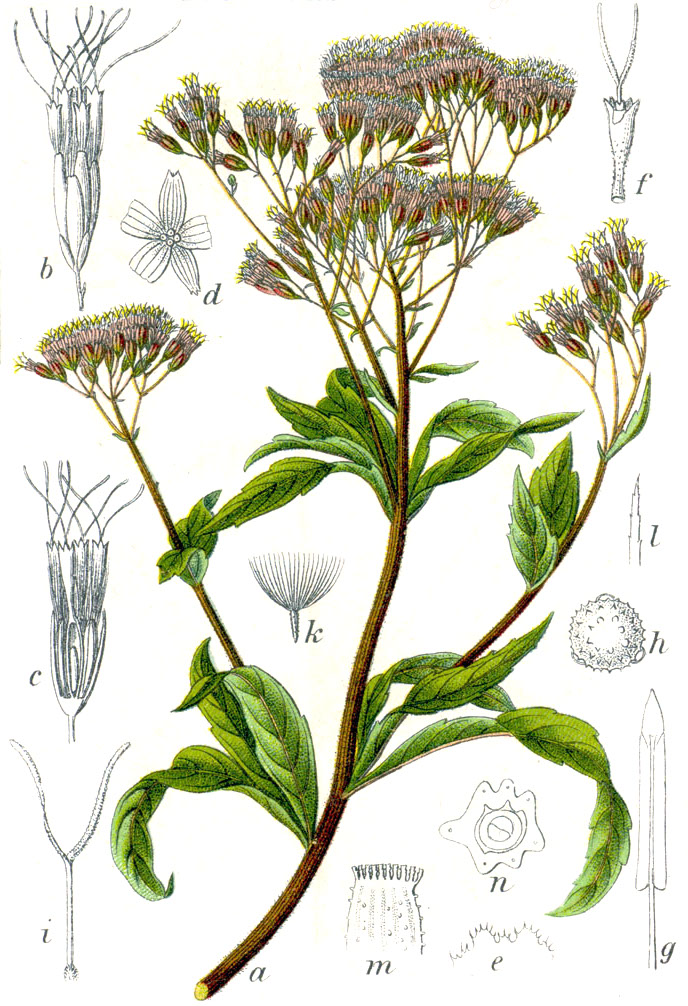
Eupatorium cannabinum by Johann Georg Sturm (Public domain, via Wikimedia Commons). Sturm (1742–1793) was a German natural history illustrator who worked with his son Jacob Sturm, a famous entomologist in his day and also an engraver.
This week’s plant is a tall native that thrives best in the west. It belongs to the daisy family (Asteraceae) but it lacks the showy ray-florets (‘petals’) that make daisies look so pretty. It is however loved by gardeners as a ‘butterfly magnet’. The sweet-smelling flowers are rich in nectar and attract moths and flies.

E. cannabinum growing by the sea, South Ayrshire. It evidently has some salt-tolerance. Photo: John Grace.
It is a perennial plant, usually growing in damp habitats, sometimes near the coast. The description of habitat in Clapham et al. (1987) is “marshes and fens, stream banks and moist woods”. I’ve seen many clumps in Ayrshire, mostly by roadsides and sometimes by the sea. The clumps occur because this plant is rhizomatous – it has lateral spreading (and rather woody) roots that act as over-wintering storage organs and sprout new shoots in the early summer.

A single stem of the species, showing the arrangement of the leaves and flowers. Photo: John Grace.
The pinkish or dull-lilac flowers are conspicuous in July and August when the sprouting stems have outgrown most of the surrounding vegetation. Stems are up to 1.5 metres tall and reddish in colour. Each of the flower heads consists of up to six tubular florets with five short ‘teeth’ around the rim. The whitish style protrudes from each floret (see Sturm’s painting above and the photo below). The bunching of the flower heads to make a single pink head helps to attract the pollinators – it provides strong visual and olfactory signals to say ‘I am here’ and also makes a convenient landing stage.

Flowering head, each flower with several florets, each floret with a protruding style. Photo: John Grace.
After flowering the seed heads become ‘frothy’, each seed having a tiny parachute (‘pappus of hairs’). Unlike most members of the daisy family, many hundreds of these will sit for days or weeks clinging together in damp air until the wind is strong enough to achieve lift-off. Then, in October, the plant dies back.


Left: leaf from the stem, showing the quite unusual trifoliate structure with outer leaflets divided into two; right: mature achenes with their pappus of simple hairs making a parachute. Photos: John Grace.
The English name Hemp Agrimony is misleading: the plant is completely unrelated to Hemp (Cannabis sativa) and Agrimony (Agrimonia eupatoria). These two species belong to other families. Hemp Agrimony gets the name ‘Hemp’ because the leaves resemble those of Hemp. The name ‘Agrimony’ for this species seems to be a confusion that began with Pliny the Elder some 2000 years ago. Pliny called Agrimony ‘Eupatorium’.
The first proper record of the species in the British Isles is said to be from 1548 when William Turner called it Eupatorium vulgare with the English name Water Hemp “because it groweth about watersydes and hath leaves lyke Hemp”. Turner was an important figure in the history of botanical science, a physician and naturalist, described as ‘the father of English botany’. As a reformer, he bravely spoke out against the authorities including King Henry VIII and had to flee the country twice.
Linnaeus properly sorted out the confusion in 1753 and described and named both Agrimonia eupatoria L. and Eupatorium cannabinum L.
There are other English names. One is ‘Raspberries and Cream’ which nicely describes the colour of the flowers. Another is ‘Holy Rope’ referring to the robe used to bind Jesus Christ. Certainly the stems are tough and fibrous and would make good rope.
You should not try to eat it. Roots and leaves are rich in pyrrolizidine alkaloids like those found in groundsel – these can cause cancer but in plants they are a defence against herbivores. It is said that only goats eat this plant. However, it has been used in folk medicine and pharmacology – but then, what plant hasn’t been used at some time or another. Searching on the Web of Science I find rather little about the ecology of the species, but many papers on the chemical and pharmacological properties. In one review paper (Al-Snafi et al. 2017) we read:
“Phytochemical analysis of Eupatorium cannabinum showed that it contained volatile oil, sesquiterpene lactones-the major one being eupatoriopicrin, polyphenols, flavonoids, pyrrolizidine alkaloids, tannins, terpenoids, saponins and immunoactive polysaccharides. The previous pharmacological studies revealed that the plant possessed cytotoxic, antimicrobial, antioxidant, anti-inflammatory, immunological, choleretic, hepatoprotective, insecticidal and repellent effects”.

British distribution of E. cannabinum showing a preference in Scotland for the west. From BSBI Maps.
But drug companies these days take rather little interest in wild plants, preferring to synthesise new active chemicals de novo. This laboratory approach is more readily scaled-up and has been more cost-effective than laboriously harvesting and extracting active compounds from plants. The genus Eupatorium does however look like a good hunting ground for new drugs.
References
Al-Snafi, AE et al. (2017) Chemical constituents, pharmacological and therapeutic effects of Eupatorium cannabinum – a review. Indo American Journal of Pharmaceutical Sciences 4, 160-168.
Clapham AR, Tutin TG and Moore DM (1987) Flora of the British Isles. Cambridge.
©John Grace
These short articles are, for me a consistent pleasure in a sorry world.
LikeLike
I too really enjoy these thoughtful, well-researched articles and always learn something new! Thanks a lot.
LikeLike
Great to have such concise details of such amazing plants, even reading about one a week is really inspiring and makes me read more about many others. Thanks for sharing these and may you continue
LikeLike